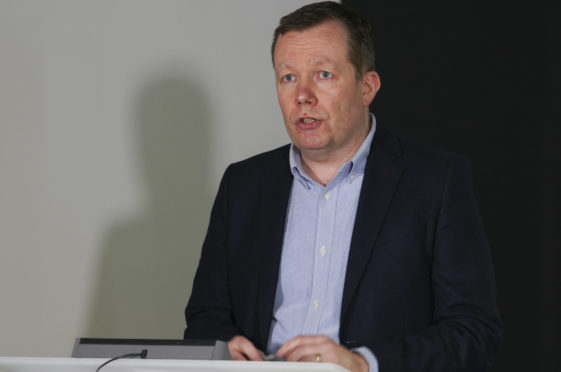
Scotland’s medical chief yesterday refused to rule out stricter lockdown restrictions for two million Scots being announced within days.
National clinical director Jason Leitch warned current restrictions in Glasgow and Lanarkshire have not led to an expected reduction in new infections.
More than half of the 1,118 new cases reported yesterday were in Glasgow and Lanarkshire, which are currently in level three restrictions.
A Scottish Government epidemic modelling report released this week suggested these rising cases may be due to people having more contact.
It said the increase was in the younger age groups – in some part due to schools going back after the October break.
Scientists say no one source is responsible and it remains unclear why infection has not dropped but the figures have prompted concern that schools, which have remained open, could be helping spread the virus.
Official figures show 29,486 pupils were off school last week due to Covid-19, an increase of 28% on the previous week. The number of absent teachers was 1,559, up 18%.
Separately, a report by the UK Government’s Scientific Advisory Group for Emergencies (Sage) said schools could be driving up infections but this was “unproven and difficult to establish”.
Sage member Calum Semple, professor of child health and outbreak medicine at Liverpool University, said: “We have reason to believe that older children, particularly the older secondary school children such as sixth formers, do have a role to play in bringing infection into households, but that’s not to say they are the most important role throughout society. The roles of retail, hospitality and health are all important as well.”
Mr Leitch said he would make a recommendation to ministers about a change to levels tomorrow and the Cabinet will take a decision when it meets on Tuesday morning.
He said: “Lanarkshire and Glasgow are stubbornly stable. They haven’t gone up the way we feared. But nor have they come down. So they seem to be stuck at 600 cases a day, roughly. And the country is up at about 1,200 cases a day. And we hoped that would have just come over the curve by now and started to fall but that hasn’t happened as quickly as we would have liked.”
Official figures show there were 400 newly reported cases in the NHS Greater Glasgow and Clyde health board area and 218 in Lanarkshire.
There were 36 reported deaths across Scotland yesterday, 1,198 were in hospital with recently confirmed Covid-19 and 92 people were intensive care.
A move to level four would see the closure of gyms, hospitality and non-essential shops, but schools would remain open despite a growing number of pupils and teachers contracting the virus.
Deputy First Minister John Swinney said on Friday government officials have warned the leaders of local authorities in Glasgow and Lanarkshire their areas could be placed in level four but schools would remain open.
Scottish ministers have insisted schools are safe but the teaching union EIS said yesterday members would consider industrial action if schools were not shut in level four areas.
EIS leader Larry Flanagan said yesterday: “The weekly figures reveal an increasingly bleak picture and are leading to calls from members for a new approach to ensuring the safety of everyone within the school community.
“With the Deputy First Minister indicating today that some parts of Scotland may soon move to level four restrictions, this will inevitably further heighten concerns over school safety and will prompt consideration of industrial action by our members, if schools are forced to remain fully open when staff feel it is unsafe to do so.”

Enjoy the convenience of having The Sunday Post delivered as a digital ePaper straight to your smartphone, tablet or computer.
Subscribe for only £5.49 a month and enjoy all the benefits of the printed paper as a digital replica.
Subscribe